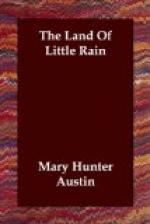I used to peek in at them, never so softly, in Dona Ina’s living-room; Raphael-eyed little imps, going sidewise on their knees to rest them from the bare floor, candles lit on the mantel to give a religious air, and a great sheaf of wild bloom before the Holy Family. Come Sunday they set out the altar in the schoolhouse, with the fine-drawn altar cloths, the beaten silver candlesticks, and the wax images, chief glory of Las Uvas, brought up mule-back from Old Mexico forty years ago. All in white the communicants go up two and two in a hushed, sweet awe to take the body of their Lord, and Tomaso, who is priest’s boy, tries not to look unduly puffed up by his office. After that you have dinner and a bottle of wine that ripened on the sunny slope of Escondito. All the week Father Shannon has shriven his people, who bring clean conscience to the betterment of appetite, and the Father sets them an example. Father Shannon is rather big about the middle to accommodate the large laugh that lives in him, but a most shrewd searcher of hearts. It is reported that one derives comfort from his confessional, and I for my part believe it.
The celebration of the Sixteenth, though it comes every year, takes as long to prepare for as Holy Communion. The senoritas have each a new dress apiece, the senoras a new rebosa. The young gentlemen have new silver trimmings to their sombreros, unspeakable ties, silk handkerchiefs, and new leathers to their spurs. At this time when the peppers glow in the gardens and the young quail cry “cuidado,” “have a care!” you can hear the plump, plump of the metate from the alcoves of the vines where comfortable old dames, whose experience gives them the touch of art, are pounding out corn for tamales.
School-teachers from abroad have tried before now at Las Uvas to have school begin on the first of September, but got nothing else to stir in the heads of the little Castros, Garcias, and Romeros but feasts and cock-fights until after the Sixteenth. Perhaps you need to be told that this is the anniversary of the Republic, when liberty awoke and cried in the provinces of Old Mexico. You are aroused at midnight to hear them shouting in the streets, “Vive la Libertad!” answered from the houses and the recesses of the vines, “Vive la Mexico!” At sunrise shots are fired commemorating the tragedy of unhappy Maximilian, and then music, the noblest of national hymns, as the great flag of Old Mexico floats up the flag-pole in the bare little plaza of shabby Las Uvas. The sun over Pine Mountain greets the eagle of Montezuma before it touches the vineyards and the town, and the day begins with a great shout. By and by there will be a reading of the Declaration of Independence and an address punctured by vives; all the town in its best dress, and some exhibits of horsemanship that make lathered bits and bloodly spurs; also a cock-fight.
By night there will be dancing, and such music! old Santos to play the flute, a little lean man with a saintly countenance, young Garcia whose guitar has a soul, and Carrasco with the violin. They sit on a high platform above the dancers in the candle flare, backed by the red, white, and green of Old Mexico, and play fervently such music as you will not hear otherwhere.




